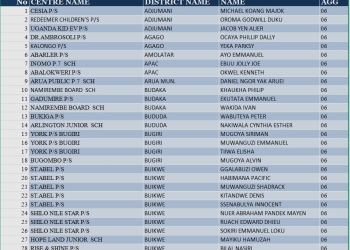 KAMPALA, Uganda – Uganda Martyrs Secondary School, Namugongo, and St Mary’s Secondary School, Kitende, have emerged as top performers in this year’s government admissions to public universities under the national merit scholarship scheme.
KAMPALA, Uganda – Uganda Martyrs Secondary School, Namugongo, and St Mary’s Secondary School, Kitende, have emerged as top performers in this year’s government admissions to public universities under the national merit scholarship scheme.
Data compiled by Vision Group from the Public Universities Joint Admissions Board (PUJAB) exercise reveals that Namugongo will send 71 students and Kitende 66, totaling 137 students from the two institutions.
An analysis of the admissions data indicates a strong emphasis on science courses, with at least 75% of the students admitted under the national merit scheme set to pursue studies in science-related fields. The remaining 25% will enroll in humanities and business programs.
Other schools with significant numbers of students admitted include St Andrew Kahwa’s College, Hoima (68), Mengo Senior School (65), King’s College Budo (59), Seeta High School (57), Amus College (46), and Gombe Secondary School (43).
King’s College Budo will have the largest cohort admitted to Makerere University on merit, with 51 students. Following closely are St Mary’s Secondary School, Kitende (50), Uganda Martyrs Secondary School, Namugongo (47), Seeta High School (41), Mengo SS (41), and Mt. St. Mary’s College Namagunga (32).
Makerere University will admit the lion’s share of students under the merit scheme, taking in 1,405 students, or 55.8% of the total 2,515 students admitted nationally on merit.
Among the other 10 public universities, Kyambogo University will admit the second-highest number of merit students with 381. Mbarara University of Science and Technology (MUST) will admit 143, and Gulu University will take in 133. Busitema University will admit 92, while Kabale and Mountains of the Moon universities will each admit 78. Lira University will admit 74, Muni University 73, and Soroti University 58.
Annually, the government provides 4,000 slots for Senior Six leavers to join public universities and tertiary institutions under its sponsorship scheme. At least 75% of these slots are awarded based on academic merit. The remaining 25% are allocated through the district quota system, with 64 slots for students with special needs and 40 for talented students.
Charles Ssentongo, the deputy academic registrar in charge of undergraduate admissions at Makerere University, noted a smaller number of students pursuing humanities under the national merit scheme compared to sciences. However, he anticipates a higher enrollment in humanities under other admission schemes, such as the district quota, diploma, and mature age entry.
“Under the district quota, Makerere admits 400 students, 350 of whom will enroll for humanities,” Ssentongo said. He added that the number of humanities students will further increase with the admission of law students, whose pre-entry examination results are pending.
This year’s admissions by PUJAB were conducted under a new application system that no longer involves LC1 chairpersons.




















